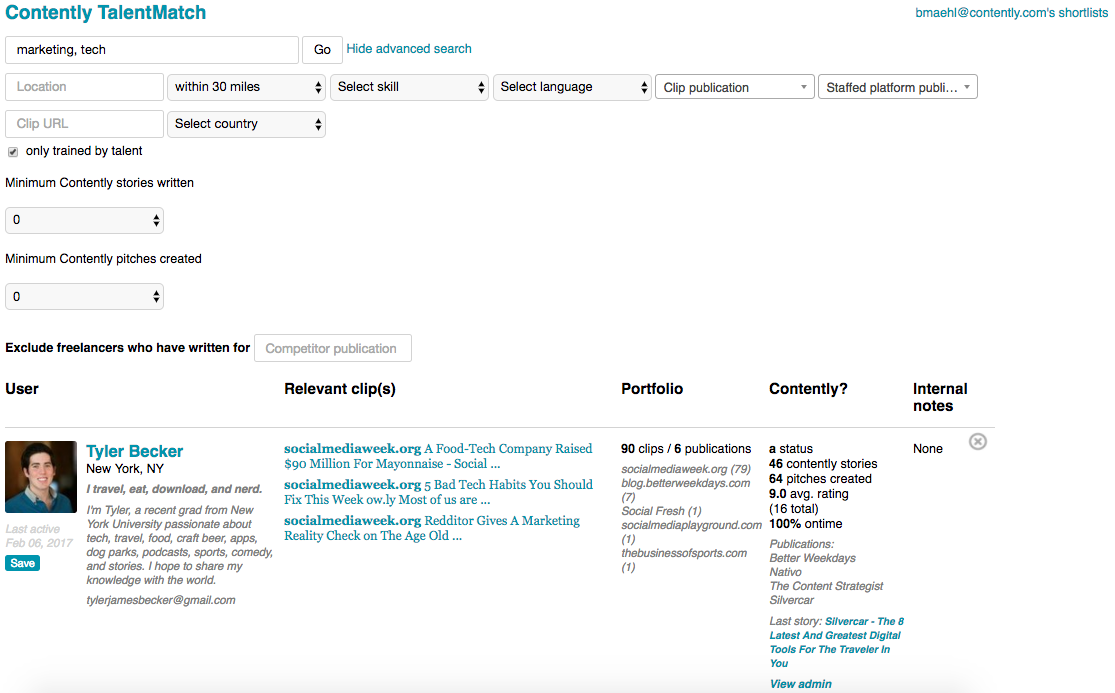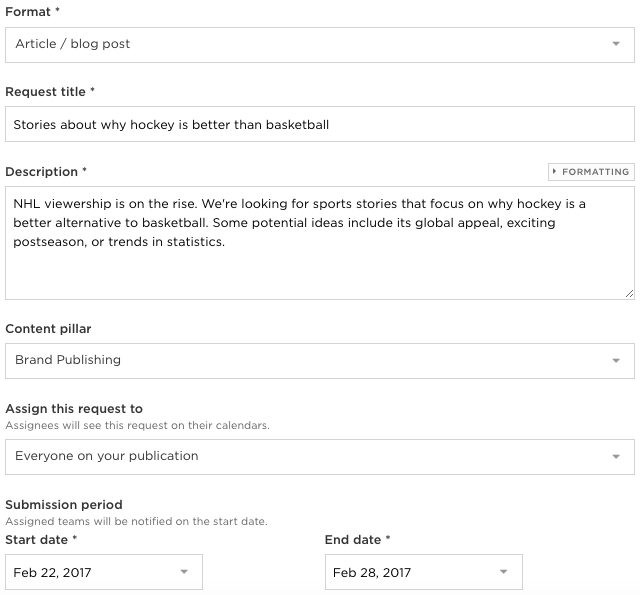Brands
4 Ways Contently Uses Analytics to Connect Brands With the Right Freelancers
Every Wednesday, a group of Contently employees grab lunch from a new restaurant in New York City. These lunches, or “Wildcard Wednesdays” as they’ve been dubbed, take a fair bit of research. We don’t wander around SoHo hoping to stumble upon a great place. Rather, we share FourSquare lists and Yelp pages to examine overall ratings, menus, and customer recommendations before making a decision.
Since we’re fortunate enough to work in the heart of one of the world’s best food cities, we wanted to take advantage of the incredible number of options for just about every cuisine imaginable. But New York’s respected culinary reputation is about more than just an abundance of choices. In theory, all of those choices could be average or subpar. What makes it worthwhile for our lunch crew is that when there are so many places to choose from, the change of finding a fantastic spot is that much greater.
At Contently, one of our key differentiators is giving clients access to our network of over 100,000 freelance creatives who come from different countries and professional backgrounds. Similar to grabbing lunch on Wednesday, the sheer number of options is only half of the appeal. The other half is building a process that can identify the right contributors for our clients.
Our talent team, which staffs our clients with contributors, used to spent most of the time manually sifting through thousands of portfolios of freelancers. Now, though, we’re using internal data collected over the last few years to improve our staffing processes so that brands can become better and more efficient publishers.
1. Getting new clients off on the right foot
In 2016, the Contently talent team paired 5,952 freelance contributors with our clients. This number looks great, but it’s also important for us to constantly track which freelancers are most active and productive.
To figure this out, we worked with our business intelligence team to pull data on the number of stories and pitches each contributor submitted. Then our developers integrated this data within TalentMatch—our internal search engine that uses an algorithm to categorize contributors based on which publications they’ve already written for and how many clips they have.

With more insight on our contributors, we can see who is ready to go and who still needs to prove themselves. Perhaps most importantly, we can provide new clients with active contributors who will deliver high-quality pitches right out of the gate.
Our long-term plan is to do this for all clients, no matter what. That’s why this data is so important. It always gives us a snapshot of contributor productivity across our network. If we only staff contributors who have written for us in the past, the talent pool won’t grow. As we bring in new clients with different needs, we’ll ideally be able to match them with new contributors who have proven to us they’re ready to take on more freelance work.
2. Introducing a contributor scoring system
In the past, there was not a way for Contently editors to rate contributors based on their first drafts or responsiveness, which led to some issues. Clients could rate contributors, but they could’ve been basing those ratings on drafts that were heavily edited. As a result, the talent team had no way of knowing if a freelancer getting a lot of work was truly worthy of their recommendations. Now, every editor has a customized rubric for grading contributors and tracking the quality of stories.
Today, editors evaluate drafts on five criteria: spelling and grammar, structure and organization, sourcing and fact-checking, responsiveness, and professionalism. With a library of quality data, we now have concrete information that guides us when figuring out who is most responsive for rush projects, strongest at fact-checking whitepapers, and most professional for phone calls.
3. Only staffing trained contributors
Staffing accounts has always been a balance. For our network to keep growing, we need to give new contributors an opportunity to work with clients, but we also understand that we can’t afford to put freelancers on accounts if they don’t understand our process. If they have strong portfolios, they’re given plenty of opportunities to complete our training courses. When a contributor doesn’t complete the training, we lose faith in their commitment and ability to impress our clients.
Thanks to our developers, we now have data on training that lives in the Contently platform. It’s also mandatory for every contributor to complete our training course before being added to an account. Gone are the days when a contributor isn’t familiar with how to pitch through the platform, how long they have to complete revisions, and what constitutes plagiarism.
4. Staying ahead of pitch requests
One of our newest product features is pitch requests, a tool that lets editors and decision-makers notify contributors if they’re looking to cover a specific topic.

We want to ensure that pitch requests are never met with silence. In response, we’ve set up alerts that tell us when pitch requests are set to expire with fewer than three responses. These notifications go to both the talent team and editors on the account so we can intervene before the publishing schedule gets delayed.
Intervention works like this:
- The talent team makes sure the request provides sufficient information
- We check existing pitches for potential matches
- We search a database of previously declined pitches for any good ideas that fulfill the request
- We package up our findings and send them to the publication’s editor
- The pitch request has more responses, or the client knows how to tweak future requests to get more responses next time
When building a content program that needs to grow quickly, the stakes are high. Recruiting the wrong freelancers, taking the time to educate them, and spending extra time on revisions can greatly hinder the ability to publish quickly. Having access to contributors, or restaurants, is a start—but only valuable so long as there’s tools to pick the best.
On rare occasions, we make a bad decision on Wildcard Wednesday (the Uncooked Turkey Burger Fiasco of 2015). But when that happens, we know to avoid that place going forward and make up for it the next week with one of our favorite spots.
Now excuse me, but it’s time to grab chicken parm.
Image by DNY59 / GettyGet better at your job right now.
Read our monthly newsletter to master content marketing. It’s made for marketers, creators, and everyone in between.




